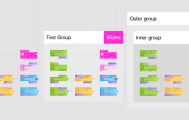Machine learning in Dreamler
- Jan 15, 2015
- By Karina Bunyik
I am Karina, a data engineer at Dreamler. I got my MSc degree in Computer Science and have 3 years of work experience in data analysis and programming. My work at Dreamler consists of designing machine learning solutions and specify the gathering of data.
Dreamler is surely not the only project planning tool available. You might ask us, well what makes Dreamler stick out from the ocean of existing tools? There are some main aspects that we strive to have in Dreamler: seamless collaboration between project members, planning using visual maps and having fun while planning. To make a user-friendly and smooth product, we’ve developed innovative software engineering solutions for the system architecture and put a lot of work into the graphical and interactive design of the user interface.
But in order to create a customized, aware and smart project planning tool, you also need something else: machine learning. Don’t let the fancy name scare you, machine learning is in fact, a set of algorithms which have intelligent-like behavior. Data is crucial for the machine learning algorithm’s input. Each algorithm assumes a complex statistical or optimization model and tries to fit the model to the data. Not all models fit well to the data and the data engineers job is to find the best fitting model of those available. After we find a good enough fit, the model can provide forecasts or pattern recognition. Forecasts can be used, for example, to predict Dreamler user behaviors. This makes Dreamler act in a smart matter by recognizing when the project takes a wrong turn, or provide assistance when the Dreamler users get stuck in planning.
Pattern recognition can capture user types like achievers, explorers, collaborators and leaders. User types like achievers usually work on their own and have high focus on completing their tasks. If a project has too many achiever types the project tasks will be completed fast, but the lack of collaboration will bring risks of working on the wrong tasks, misinterpretation of specification and goals. Identifying user types can therefore give information about possible problems in the composition of the user behavior types within the team. Pattern recognition can also describe with a few words what the project is about or create short summaries of project documents.
Currently we are working on the design of the following machine learning features: Project Topic Discovery and Activity Well-formulation. Project Topic Discovery will sum up for the project participants what the project is about. Activity Well-formulation analyzes the grammar of task descriptions to make sure that the task is formulated in a way so that the actual action to be taken is articulated, for example that a task title contains a verb.
You can read about these features in more detail in my next blog post. Please comment if you have any questions about machine learning and Dreamler.





